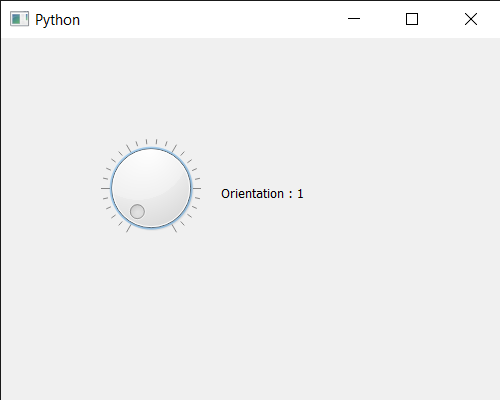En este artículo, veremos cómo podemos obtener la propiedad de orientación de QDial. Esta propiedad mantiene la orientación del control deslizante, la orientación debe ser Vertical (predeterminada) u Horizontal. Para la orientación vertical, el valor asociado es 2 y para la orientación horizontal, es 1, se puede establecer en QDial con la ayuda del setOrientationmétodo.
Para hacer esto usamos orientationel método con el objeto QDial
Sintaxis: marcar.orientación()
Argumento: no requiere argumento
Devolución: devuelve el objeto de orientación pero cuando se imprime muestra el valor asociado de orientación
A continuación se muestra la implementación.
# importing libraries
from PyQt5.QtWidgets import *
from PyQt5 import QtCore, QtGui
from PyQt5.QtGui import *
from PyQt5.QtCore import *
import sys
class Window(QMainWindow):
def __init__(self):
super().__init__()
# setting title
self.setWindowTitle("Python ")
# setting geometry
self.setGeometry(100, 100, 500, 400)
# calling method
self.UiComponents()
# showing all the widgets
self.show()
# method for components
def UiComponents(self):
# creating QDial object
dial = QDial(self)
# setting geometry to the dial
dial.setGeometry(100, 100, 100, 100)
# making notch visible
dial.setNotchesVisible(True)
# setting orientation to it
dial.setOrientation(Qt.Horizontal)
# creating a label
label = QLabel("GeeksforGeeks", self)
# setting geometry to the label
label.setGeometry(220, 125, 200, 60)
# making label multiline
label.setWordWrap(True)
# getting orientation
value = dial.orientation()
# setting text to the label
label.setText("Orientation : " + str(value))
# create pyqt5 app
App = QApplication(sys.argv)
# create the instance of our Window
window = Window()
# start the app
sys.exit(App.exec())
Producción :
Publicación traducida automáticamente
Artículo escrito por rakshitarora y traducido por Barcelona Geeks. The original can be accessed here. Licence: CCBY-SA